Foraging and blending wild herbs for tea rituals offers a unique way to connect with nature and create personalized brews. You'll need basic tools like pruning shears, a basket, and a field guide to get started. Learn to identify safe, edible plants like chamomile, peppermint, and nettle while being aware of toxic look-alikes. Practice sustainable harvesting by taking only what you need and rotating collection areas. Dry and store your herbs properly to preserve their flavors and medicinal properties. Experiment with different combinations to create balanced blends that suit your taste and wellness goals. Crafting your own wild tea ceremony can be a deeply rewarding experience that awakens your senses and nourishes your spirit.
The Art of Wild Tea Foraging
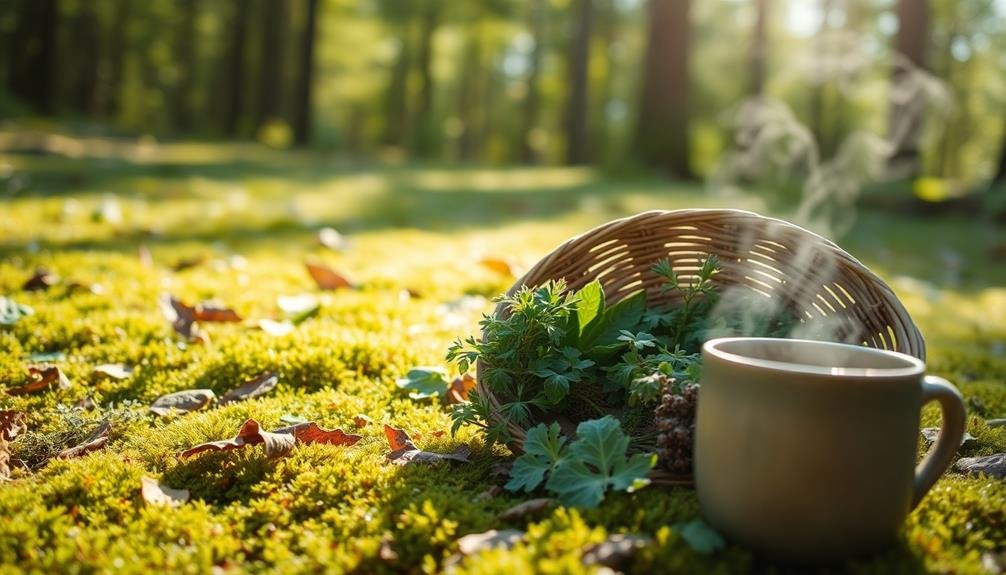
One might think foraging for wild herbs is a lost art, but it's making a comeback among tea enthusiasts. You'll find that wild tea foraging offers a unique connection to nature and your local environment.
To start, research common edible plants in your area and learn to identify them confidently. Always carry a reliable field guide and consider joining a local foraging group for hands-on experience.
When you're ready to forage, respect nature and follow local regulations. Only harvest from areas free of pesticides and pollutants. Take only what you need, leaving plenty for wildlife and plant regrowth. Use clean, sharp scissors or pruning shears to avoid damaging the plants.
Focus on herbs like chamomile, mint, lemon balm, and nettle, which are often abundant and make excellent teas. Harvest in the morning after the dew has dried but before the sun becomes too strong. This guarantees the herbs retain their essential oils and flavors.
Once you've collected your herbs, dry them thoroughly before storing. Hang them in small bunches or lay them on screens in a warm, dry place.
With practice, you'll develop a keen eye for wild herbs and create unique, personalized tea blends.
Essential Tools for Herb Gathering
Preparedness is key when venturing out to gather wild herbs for your tea rituals. You'll need a few essential tools to guarantee a successful and sustainable foraging experience.
First, invest in a good pair of pruning shears or scissors for clean, precise cuts that won't damage the plants. A sturdy basket or cloth bag will help you carry your harvest without crushing delicate leaves and flowers.
Don't forget to bring a reliable field guide to help you identify plants accurately. A magnifying glass can be invaluable for examining small details that distinguish similar species. Protect your hands with gardening gloves, especially when handling prickly or irritating plants. A small trowel may be necessary if you're harvesting roots.
Always carry a water bottle to stay hydrated and a first-aid kit for emergencies. A GPS device or map and compass will help you navigate unfamiliar terrain.
Seasonal Wildcrafting Calendar
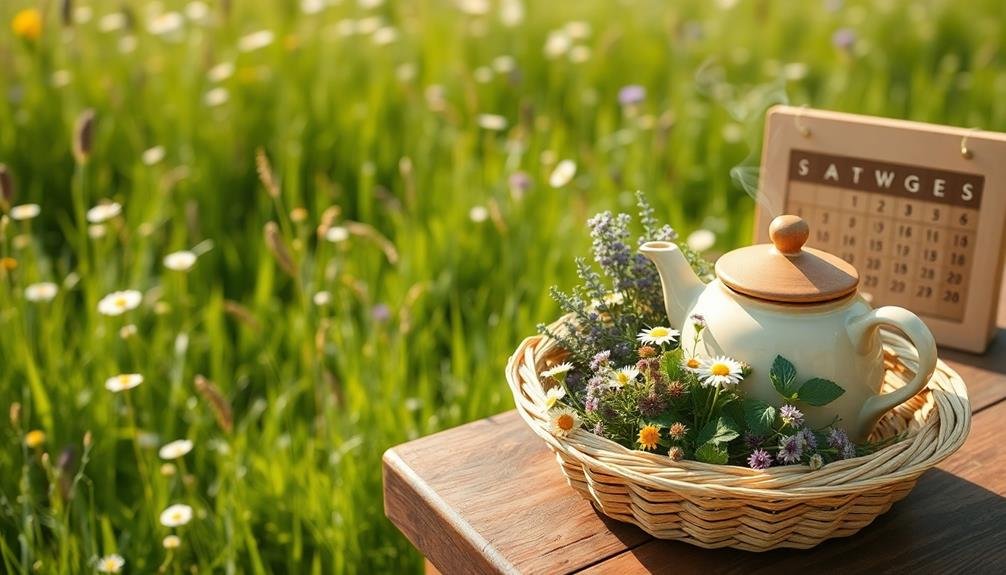
Armed with the right tools, you're ready to explore the world of wild herbs throughout the year. A seasonal wildcrafting calendar will guide you in harvesting the best herbs at their peak potency.
In spring, look for dandelion leaves, nettle shoots, and wild mint. These early risers offer fresh, vibrant flavors for your teas.
As summer arrives, you'll find an abundance of herbs. Harvest chamomile flowers, lemon balm, and St. John's wort during this time.
Don't forget to collect rose petals and elderflowers for their delicate aromas. Late summer brings opportunities to gather raspberry and blackberry leaves.
Fall is prime time for rosehips, rich in vitamin C. You can also collect goldenrod flowers and mullein leaves.
As winter approaches, focus on evergreen plants like pine needles and cedar tips. These provide a revitalizing boost during colder months.
Remember to adjust your calendar based on your local climate and ecosystem.
Always practice sustainable foraging by harvesting only what you need and leaving plenty for wildlife and plant regeneration.
Identifying Safe Herbal Tea Ingredients
When foraging for wild herbs to use in your tea rituals, you'll need to accurately identify common edible plants.
You'll find many safe options like chamomile, mint, and dandelion growing in fields and forests.
However, it's essential to be aware of toxic look-alikes that can pose serious health risks if mistaken for edible herbs.
Common Edible Wild Herbs
Throughout the countryside and even in urban areas, you'll find a variety of common edible wild herbs suitable for making herbal teas. Some of the most widespread and easily recognizable plants include dandelion, chamomile, and peppermint. These herbs don't just offer unique flavors; they're also packed with potential health benefits.
Dandelion leaves and roots can be used to create a slightly bitter tea that's rich in vitamins and minerals. Chamomile flowers produce a soothing, apple-like flavor and are known for their calming properties. Peppermint leaves make an invigorating, cooling tea that can aid digestion.
Other common wild herbs you might encounter include:
- Nettle: High in iron and other nutrients, it has an earthy, spinach-like taste
- Lemon balm: Offers a mild citrusy flavor and is believed to reduce stress
- Elderflower: Provides a sweet, floral taste and is rich in antioxidants
When foraging for these herbs, always verify you're in an area free from pesticides and pollutants.
It's essential to positively identify each plant before harvesting, as some wild plants can be toxic. If you're unsure, consult a local expert or field guide before consuming any wild herbs.
Toxic Look-Alike Warnings
While identifying common edible wild herbs can be exciting, it's important to be aware of potentially dangerous look-alikes. Always double-check your identification before consuming any wild plant. Some toxic plants closely resemble edible ones, making proper identification vital.
Be cautious of hemlock, which resembles Queen Anne's lace or wild carrot. Hemlock is highly poisonous and can be fatal if ingested.
Avoid pokeweed, which might be mistaken for edible greens like spinach or collards. Pokeweed's berries and roots are toxic.
Watch out for deadly nightshade, which can be confused with blackberries or blueberries. Its berries are highly poisonous.
Don't mistake water hemlock for wild parsnip or celery; it's one of North America's most toxic plants.
Be wary of false hellebore, which resembles wild leeks or ramps. All parts of false hellebore are poisonous.
Finally, avoid mistaking poison hemlock for wild fennel or parsley. Poison hemlock is extremely toxic and can cause respiratory failure.
Always use reliable field guides, consult experts, and consider taking foraging classes to learn proper identification techniques. Your safety depends on accurate plant recognition.
Sustainable Harvesting Practices
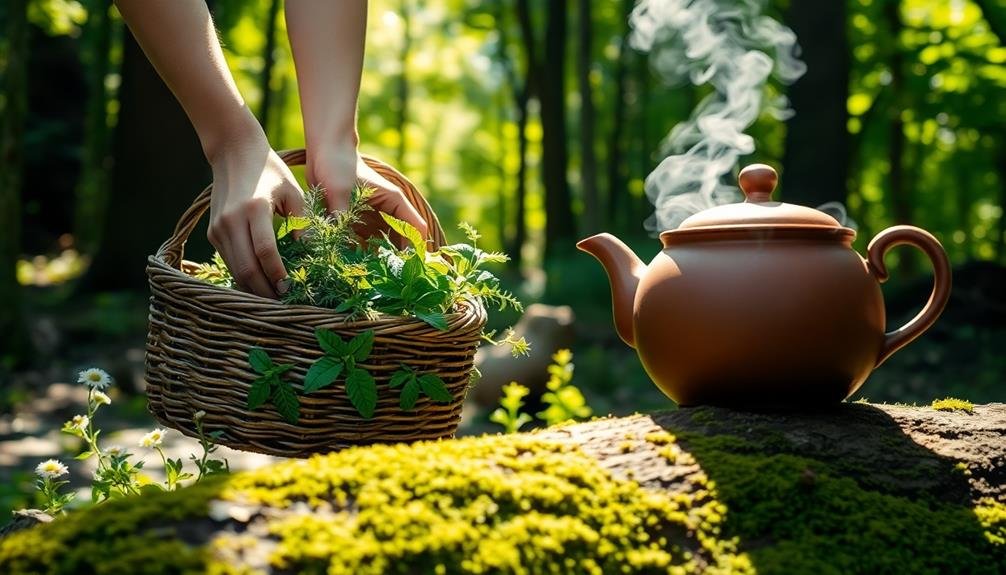
Sustainable harvesting practices lie at the heart of responsible wild herb collection for tea rituals. As you venture into nature's pantry, it's vital to minimize your impact on the environment. Always harvest less than 10% of a plant population, ensuring you leave enough for wildlife and future growth.
Rotate your collection areas to prevent overexploitation of specific locations. When harvesting, use clean, sharp tools to make precise cuts, reducing damage to the plant. Focus on collecting only the parts you need, such as leaves or flowers, rather than uprooting entire plants.
It's important to properly identify plants and understand their growth cycles before harvesting. To further protect wild herb populations:
- Collect seeds and scatter them in suitable areas to promote regeneration
- Avoid harvesting rare or endangered species
- Learn about local regulations and obtain necessary permits
Drying and Storing Foraged Herbs
After you've responsibly harvested your wild herbs, proper drying and storage are key to preserving their flavor and medicinal properties.
Start by gently rinsing your herbs to remove dirt and insects, then pat them dry with a clean towel. Arrange the herbs in a single layer on drying racks or hang them in small bundles in a warm, dry, and well-ventilated area away from direct sunlight.
The drying process typically takes 1-2 weeks, depending on the herb and environmental conditions. You'll know they're ready when the leaves crumble easily between your fingers.
Once dried, store your herbs in airtight glass jars or sealed paper bags in a cool, dark place.
Label each container with the herb name and harvest date. For peak freshness, use your dried herbs within 6-12 months.
To preserve delicate flavors, avoid crushing or grinding the herbs until you're ready to use them. If you notice any signs of mold or unusual odors, discard the affected herbs immediately.
Creating Balanced Wild Tea Blends
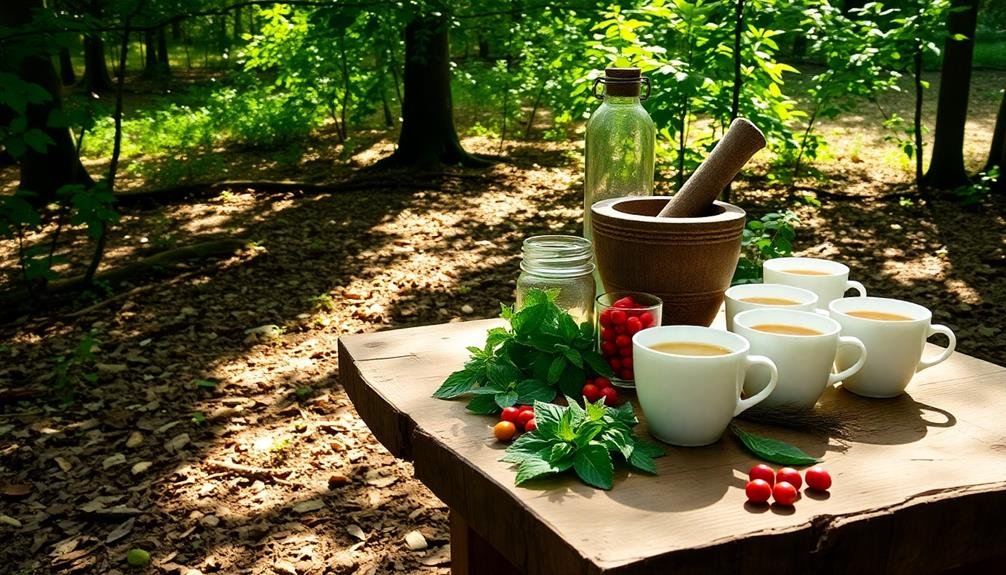
When crafting wild tea blends, you'll want to contemplate complementary flavor profiles to create a harmonious taste experience.
It's also important to balance the medicinal properties of different herbs, ensuring your blend supports your wellness goals without overwhelming your system.
As you experiment with seasonal herb combinations, you'll discover how the changing availability of plants throughout the year can inspire unique and revitalizing tea blends.
Complementary Flavor Profiles
Creating balanced wild tea blends is an art that relies on understanding complementary flavor profiles. When you're foraging for wild herbs, contemplate how their flavors will interact and enhance each other.
Start by identifying the primary taste of each herb: sweet, bitter, astringent, or aromatic. Then, pair contrasting flavors to create a well-rounded blend.
For example, combine the sweetness of wild mint with the slight bitterness of dandelion leaves. Or, balance the earthy notes of nettle with the floral aroma of wild rose petals.
Don't forget to contemplate the intensity of each herb's flavor. A strongly flavored herb like wild thyme should be used sparingly to avoid overpowering more delicate ingredients.
When crafting your wild tea blends, keep these principles in mind:
- Aim for a harmonious balance of flavors
- Include a variety of taste profiles in each blend
- Adjust proportions to achieve the desired flavor intensity
Balancing Medicinal Properties
Beyond flavor profiles, wild tea blends offer a unique opportunity to harness the medicinal properties of various herbs. When creating balanced wild tea blends, you'll need to take into account the therapeutic effects of each herb and how they interact.
Start by researching the properties of your foraged herbs, noting their potential benefits and contraindications. Aim for a synergistic blend that addresses specific health concerns or wellness goals. For example, you might combine chamomile for relaxation, peppermint for digestion, and elderflower for immune support.
Be mindful of potency; some herbs are more powerful than others and should be used sparingly. It's essential to balance stimulating herbs like nettle or rosemary with calming ones such as lemon balm or lavender.
Reflect on the time of day you'll be drinking your tea. Morning blends can include energizing herbs like dandelion root or chicory, while evening blends might focus on sleep-promoting herbs like valerian or passionflower.
Always err on the side of caution and consult with a healthcare professional, especially if you're pregnant, nursing, or taking medications. By thoughtfully balancing medicinal properties, you'll create wild tea blends that nourish both body and spirit.
Seasonal Herb Combinations
Nature's rhythm offers a unique opportunity to craft seasonal wild tea blends that celebrate each time of year. As you forage for herbs, consider the natural cycles and what's abundantly available in your area.
Spring blends might feature tender nettle leaves, fragrant violets, and wild mint, while summer invites the addition of sun-kissed chamomile and lemon balm.
In autumn, embrace warming spices like wild ginger and rosehips, rich in vitamin C. Winter calls for heartier blends, incorporating pine needles and dried berries.
When creating your seasonal combinations, remember to balance flavors and therapeutic properties. You'll want to include:
- A base herb for volume and mild flavor
- A feature herb for distinct taste or medicinal benefit
- An accent herb to add complexity or enhance effects
Don't be afraid to experiment with different ratios to find your perfect blend. Start with equal parts of each herb, then adjust to suit your taste.
Keep in mind that some herbs are more potent than others, so use stronger flavors sparingly. By tuning into nature's seasons, you'll create unique, nourishing teas that connect you to the ever-changing world around you.
Medicinal Properties of Wild Herbs
Throughout history, wild herbs have been prized for their medicinal properties. You'll find that many common wild herbs offer a range of health benefits when consumed as tea.
Chamomile, for instance, is known for its calming effects and can help with sleep and anxiety. Peppermint tea aids digestion and relieves nausea, while nettle tea is rich in nutrients and may help reduce inflammation.
Elderflower tea can boost your immune system and alleviate cold symptoms, and dandelion root tea supports liver health and acts as a natural diuretic. If you're looking for respiratory support, try mullein tea, which can help soothe coughs and congestion. Rosehip tea is packed with vitamin C and antioxidants, supporting overall health and skin vitality.
When foraging for these herbs, it's imperative to correctly identify plants and avoid contaminated areas.
Always consult with a healthcare professional before using wild herbs medicinally, especially if you have existing health conditions or are taking medications. While these herbs can offer numerous benefits, it's important to use them responsibly and in moderation as part of a balanced approach to health and wellness.
Crafting a Personalized Tea Ceremony
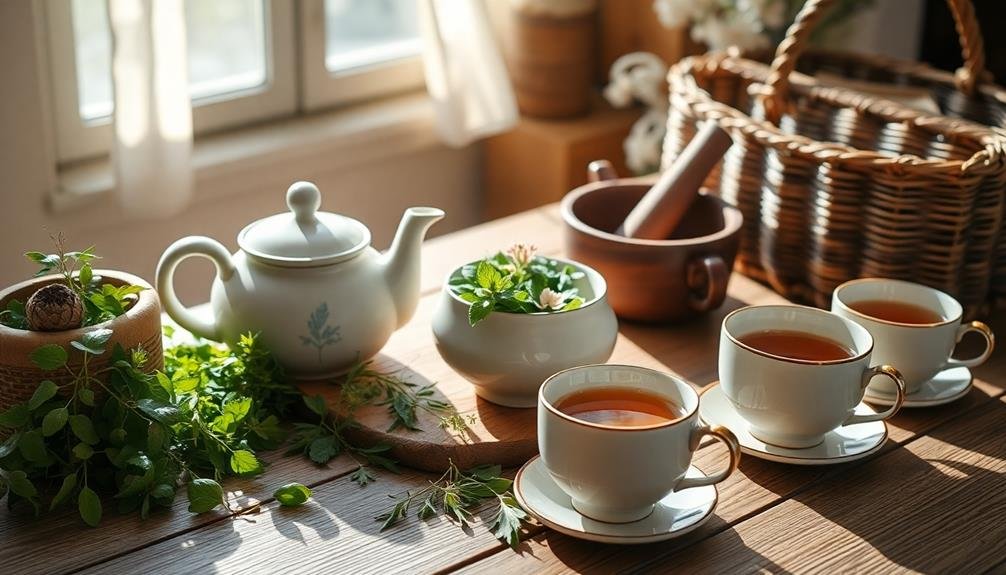
Once you've gathered your wild herbs, it's time to create a personalized tea ceremony that reflects your unique tastes and intentions.
Start by selecting a quiet, comfortable space where you can fully immerse yourself in the experience. Choose a special teapot or mug that resonates with you, and prepare your chosen blend of wild herbs.
As you craft your ceremony, consider incorporating elements that engage all your senses:
- Visual: Arrange your tea set and herbs aesthetically
- Auditory: Play soft, calming music or nature sounds
- Olfactory: Inhale the aromatic steam from your brew
Begin your ritual by taking a few deep breaths to center yourself. As you steep your tea, focus on the present moment and the natural gifts you're about to enjoy.
When ready, pour your tea mindfully, observing the color and aroma. Sip slowly, savoring the flavors and allowing the warmth to spread through your body.
Pairing Wild Teas With Food
When pairing wild teas with food, you'll want to contemplate complementary flavor profiles to enhance your dining experience.
You can explore regional food pairings that match local wild teas with traditional dishes from the same area.
Additionally, you might focus on health-oriented combinations, selecting wild teas and foods that offer synergistic nutritional benefits.
Complementary Flavor Profiles
Tea enthusiasts know that pairing wild herbal teas with the right foods can elevate both the beverage and the meal. When selecting complementary flavor profiles, consider the tea's dominant notes and match them with foods that share similar or contrasting characteristics. For example, pair a minty wild tea with chocolate desserts or lamb dishes to create a harmonious blend of flavors.
When exploring complementary flavor profiles, keep these principles in mind:
- Balance intensity: Match delicate teas with light foods and robust teas with heartier dishes.
- Consider seasonality: Align your tea and food choices with the current season for ideal freshness.
- Experiment with textures: Contrast smooth teas with crunchy snacks or creamy desserts.
Don't be afraid to mix sweet and savory elements. A floral wild tea like chamomile can complement both a fruit tart and a savory cheese plate.
Earthy teas, such as those made from dandelion root or chicory, pair well with rich, umami-packed foods like mushroom risotto or grilled meats. By exploring these complementary flavor profiles, you'll enhance your tea-drinking experience and discover new culinary delights.
Regional Food Pairings
Exploring regional food pairings can transform your wild tea experience into a global culinary adventure. As you sip your foraged brews, consider complementing them with local dishes that highlight the tea's unique characteristics. You'll find that certain wild teas pair exceptionally well with specific regional cuisines, enhancing both the beverage and the food.
Here's a guide to help you match your wild teas with regional specialties:
| Wild Tea | Region | Cuisine | Pairing Suggestion |
|---|---|---|---|
| Nettle | Northern Europe | Scandinavian | Smoked salmon on rye |
| Lemon Verbena | Mediterranean | Greek | Feta and olive salad |
| Rosehip | North America | Southwestern | Spicy black bean tacos |
| Dandelion | Central Europe | German | Bratwurst with sauerkraut |
When pairing wild teas with food, consider the tea's flavor profile, aroma, and intensity. Light, floral teas often complement delicate dishes, while robust, earthy teas can stand up to heartier fare. Don't be afraid to experiment with unexpected combinations – you might discover a new favorite pairing that brings out the best in both your foraged tea and regional cuisine.
Health-Focused Combinations
Wellness enthusiasts often seek powerful combinations of wild teas and nutritious foods to maximize health benefits.
You'll find that pairing foraged herbs with specific foods can amplify their therapeutic effects. For instance, combine nettle tea with iron-rich foods like spinach or lentils to boost iron absorption.
Dandelion root tea's liver-cleansing properties work well with detoxifying foods such as beets and garlic.
For inflammation reduction, pair turmeric-infused wild ginger tea with black pepper and healthy fats like avocado or nuts. This combination enhances curcumin absorption, maximizing its anti-inflammatory effects.
When fighting colds, drink elderberry tea alongside vitamin C-rich foods like citrus fruits or bell peppers to strengthen your immune system.
Consider these health-focused combinations:
- Chamomile tea with probiotic-rich yogurt for gut health
- Rosehip tea with omega-3 rich fish for skin health
- Mint tea with fiber-rich whole grains for digestion
Sharing the Wild Tea Experience
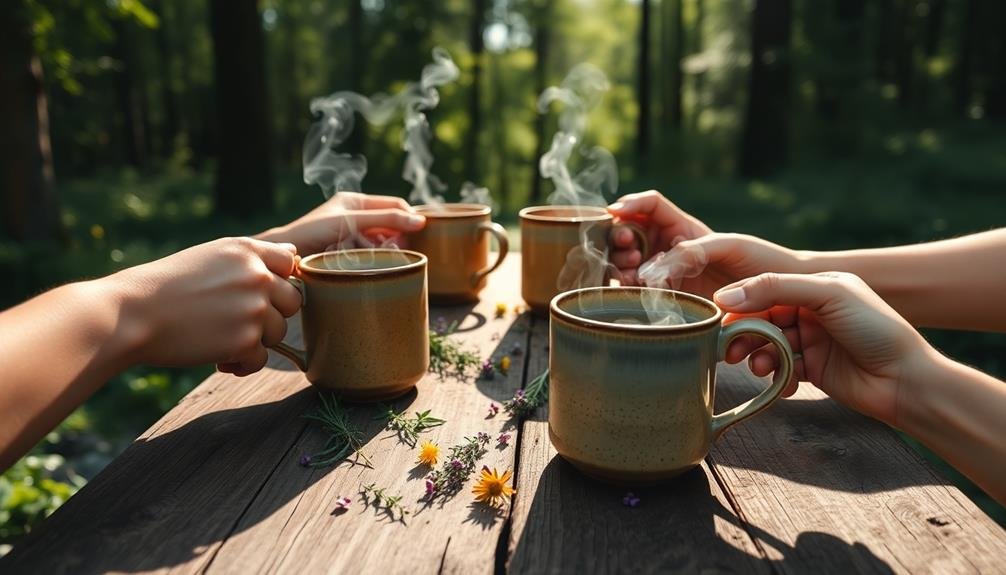
Through the act of sharing, the wild tea experience takes on new dimensions. You'll find that inviting others to partake in your foraged tea blends creates a unique connection to nature and each other. Organize tea-tasting gatherings where participants can sample various wild herb combinations and share their impressions. Encourage them to describe the flavors, aromas, and sensations they experience.
To enhance the sharing experience, consider creating a tea-tasting journal. Document your blends, their ingredients, and the reactions of those who try them. This record will help you refine your recipes and remember successful combinations.
| Sharing Method | Benefits | Tips |
|---|---|---|
| Tea Parties | Social bonding | Provide tasting notes |
| Workshops | Educational | Incorporate foraging walks |
| Gift-giving | Personal touch | Include brewing instructions |
Don't forget to share your knowledge about sustainable foraging practices and plant identification. This guarantees that others can safely and responsibly enjoy wild tea experiences. By sharing your passion for wild herb teas, you're not only spreading the joy of nature's flavors but also fostering a deeper appreciation for the environment and its bounty.
Frequently Asked Questions
Can Wild Herbs Be Mixed With Commercial Teas for Unique Blends?
You can definitely mix wild herbs with commercial teas for unique blends. It's a great way to experiment and create custom flavors. Try adding foraged herbs like mint, chamomile, or lavender to your favorite black or green tea.
Are There Any Legal Restrictions on Foraging Herbs in Public Spaces?
You'll find legal restrictions on foraging herbs in public spaces vary by location. Check local laws before harvesting. Many areas prohibit foraging in parks or protected lands. Always get permission on private property. Don't over-harvest; respect nature.
How Long Does It Take to Become Proficient in Wild Herb Identification?
You'll need several months to years of dedicated practice to become proficient in wild herb identification. Start with common plants, study field guides, join local foraging groups, and practice regularly. It's a lifelong learning process you'll continually improve upon.
Can Children Safely Participate in Wild Tea Foraging and Preparation?
You can involve children in wild tea foraging, but it's essential to supervise them closely. Teach them to identify safe plants, avoid toxic ones, and never taste anything without your approval. Always double-check their findings before brewing.
Are There Any Known Allergies or Contraindications for Specific Wild Herbs?
Yes, there are known allergies and contraindications for specific wild herbs. You'll need to research each herb carefully before using it. Some can interact with medications or cause allergic reactions in sensitive individuals. Always consult a healthcare professional first.
In Summary
You've now commenced on a journey into the world of wild tea foraging. Armed with knowledge and tools, you're ready to explore nature's pharmacy. Remember to harvest responsibly and respect the environment. As you craft your personalized blends and rituals, you'll discover a deeper connection to the earth and its healing gifts. Share your creations with loved ones, and let wild teas nourish your body and soul. Happy foraging!

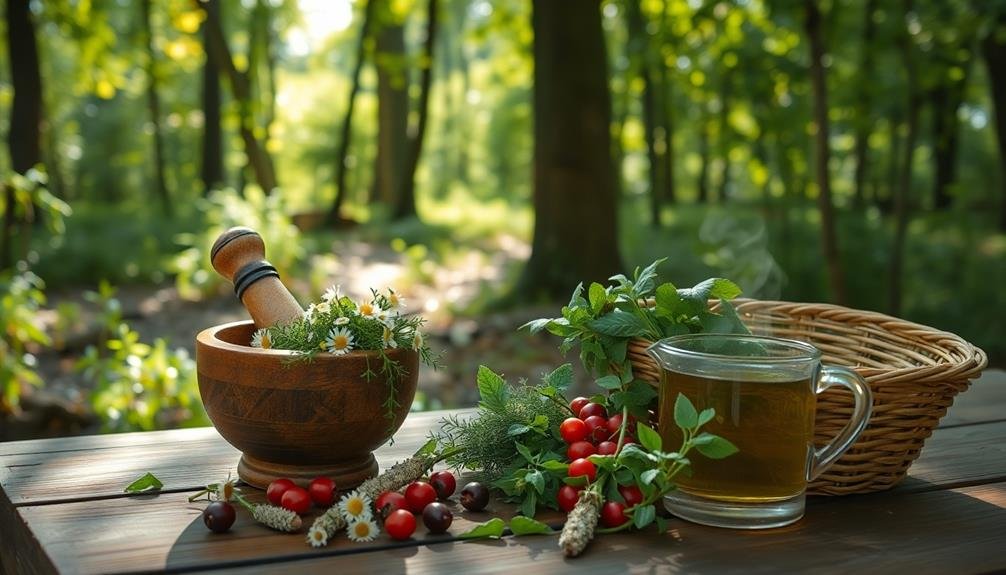
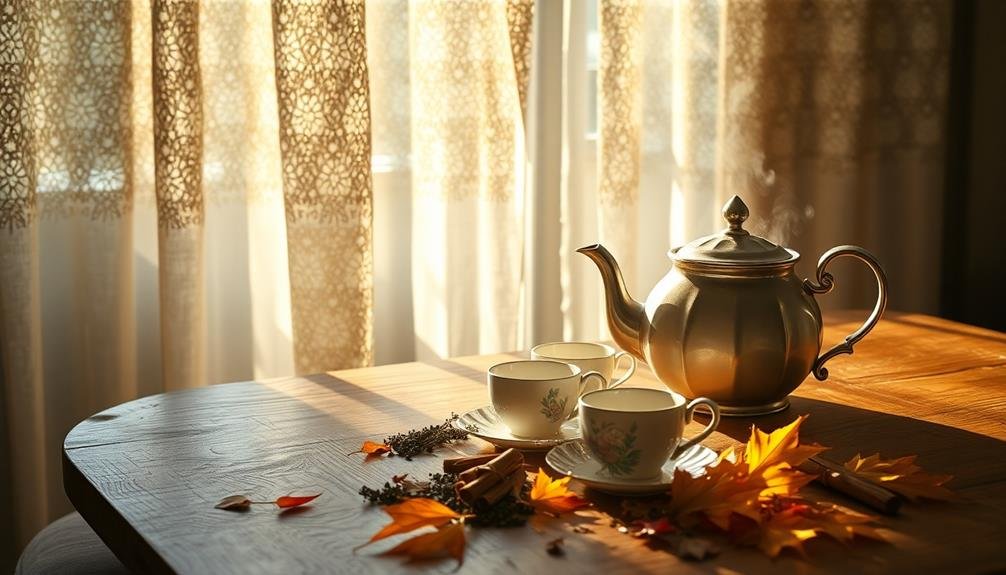
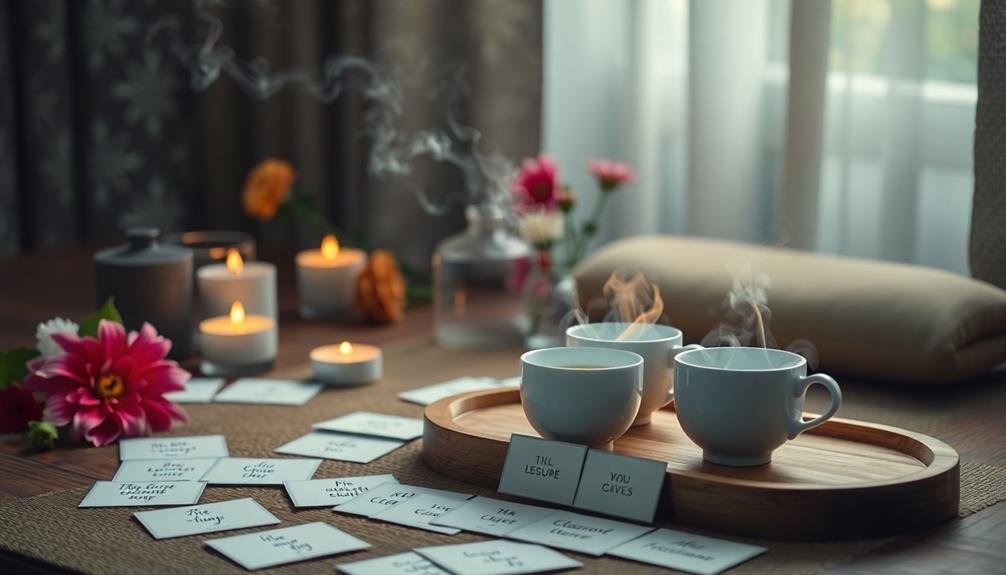
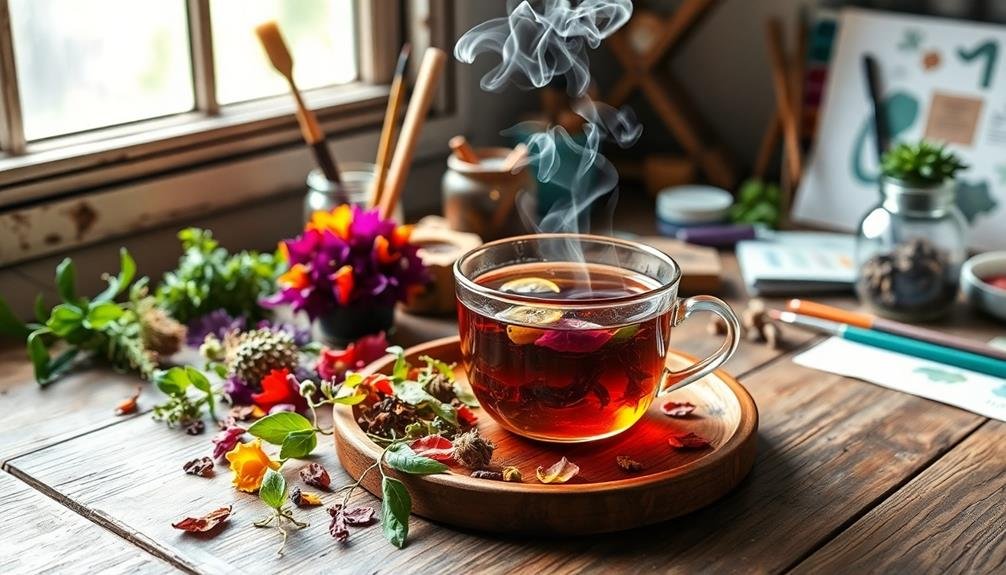
Leave a Reply